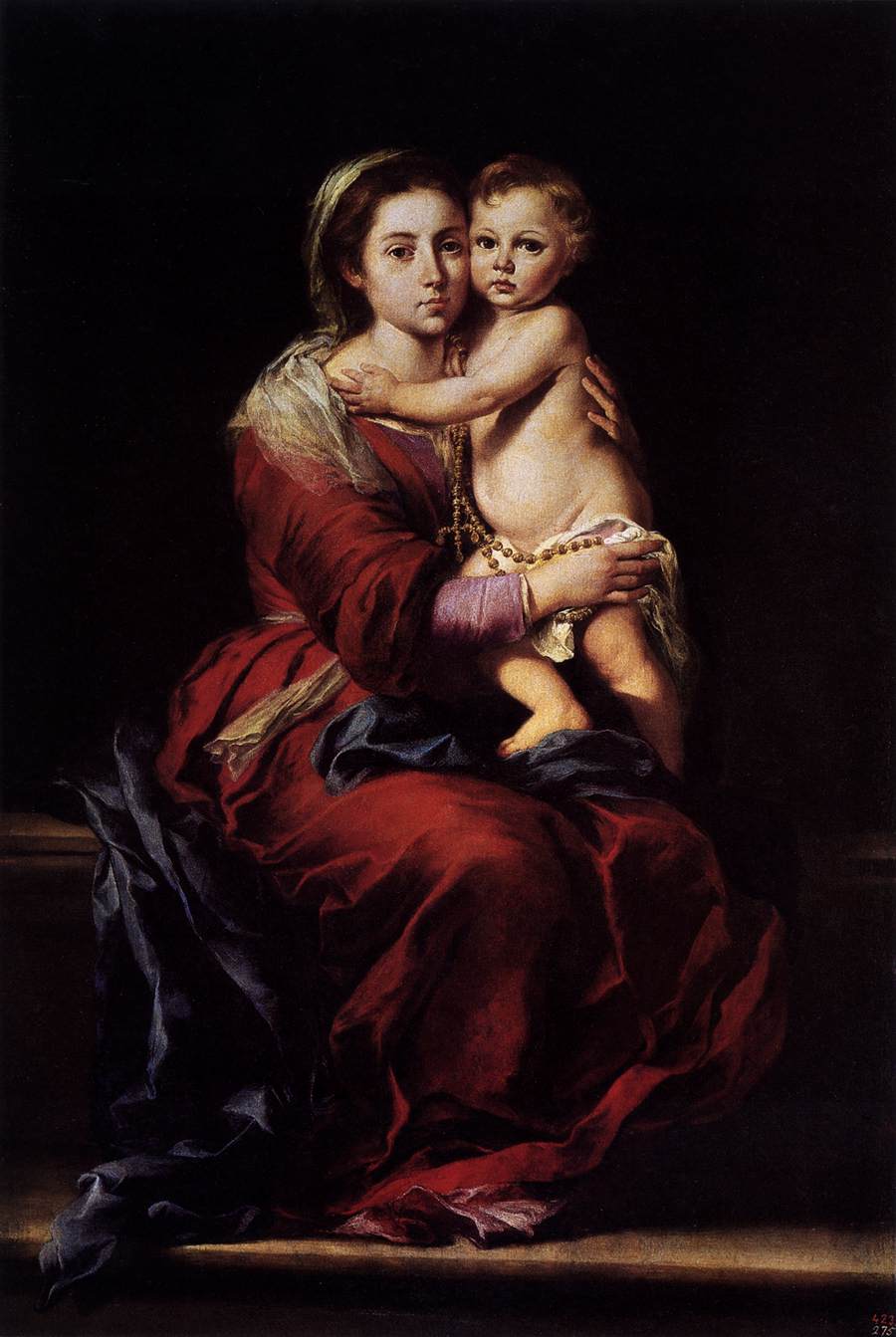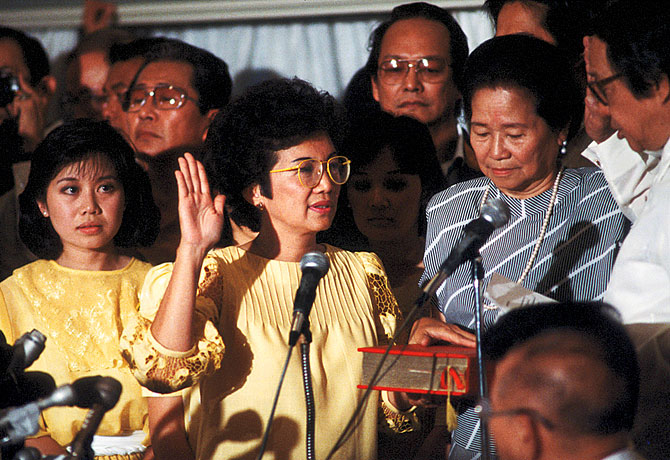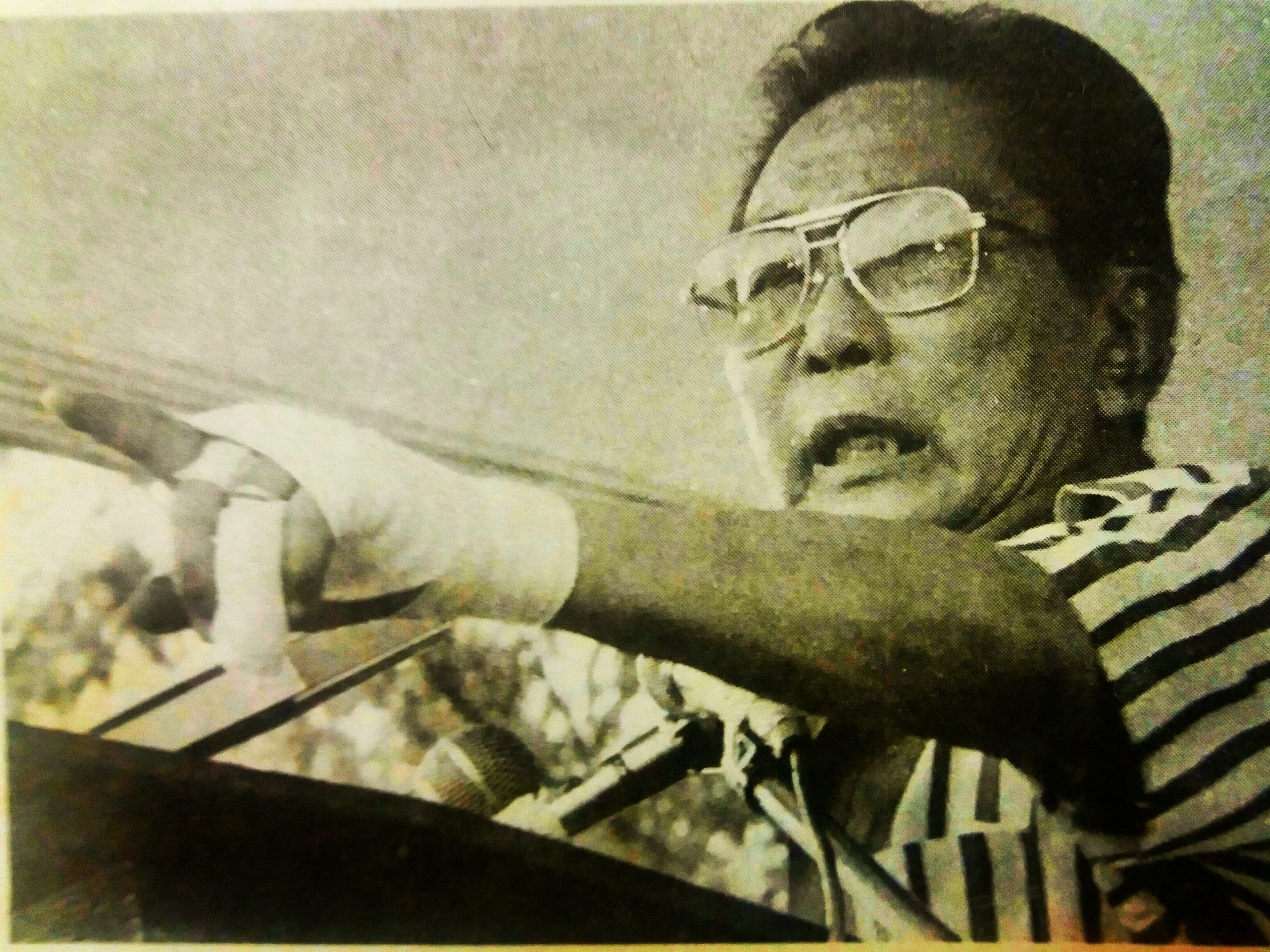|
EDSA Shrine
The Shrine of Mary, Queen of Peace, Our Lady of EDSA, or more popularly, the EDSA Shrine is a small church of the Roman Catholic Archdiocese of Manila located at the intersection of Ortigas Avenue and Epifanio de los Santos Avenue (EDSA) in Barangay Ugong Norte, Quezon City. The church is also called the Archdiocesan Shrine of Mary, Queen of Peace or Mary, Queen of Peace Quasi-Parish, although these names are seldom used. It is also a declared Important Cultural Property by the National Commission for Culture and the Arts. Built in 1989 on donated land to commemorate the People Power Revolution, the shrine is the site of two peaceful demonstrations that toppled Presidents Ferdinand Marcos (the People Power Revolution or EDSA I) in 1986, and Joseph Estrada (the EDSA Revolution of 2001 or EDSA II). The EDSA Shrine is the northernmost tip of the Ortigas Center, a financial and commercial district occupying large tracts of land in Quezon City, Mandaluyong, and Pasig. History Archbi ... [...More Info...] [...Related Items...] OR: [Wikipedia] [Google] [Baidu] |
Ortigas Center
Ortigas Center is a central business district located within the joint boundaries of Pasig, Mandaluyong and Quezon City, within the Metro Manila region in the Philippines. With an area of more than , it is Metro Manila's second most important business district after the Makati CBD. It is governed by Ortigas Center Association, Inc. Ortigas Center is home to many shopping malls, office and condominium skyscrapers, nightlife bars, restaurants and other building complexes. These include the St. Francis Square, the Asian Development Bank compound, the Oakwood Premier serviced apartments and a Shangri-La hotel. It is also the headquarters of San Miguel Corporation, Jollibee Foods Corporation, Viva Communications, Century Pacific Food, the Philippine branch of HSBC, Republic Biscuit Corporation (Rebisco), and Robinsons Galleria. Also present in the area are Philippine offices of prominent engineering firms such as Parsons Brinckerhoff, Sinclair Knight Merz, and WSP Group. It also home ... [...More Info...] [...Related Items...] OR: [Wikipedia] [Google] [Baidu] |
EDSA Revolution Of 2001
{{SIA ...
EDSA Revolution of 2001 refers to either of two consecutive events relating to a change of power in the Philippines over the course of the first four months of 2001. These are: *EDSA II in January 2001 that toppled President Joseph Estrada after an aborted impeachment trial *EDSA III in April 2001 that climaxed in a failed siege of the presidential palace by Estrada's supporters See also * EDSA (other) EDSA stands for "Epifanio de los Santos Avenue", a highway around Metro Manila, Philippines. EDSA may also refer to: EDSA in the Philippines * People Power Revolution, known as EDSA I, of 1986 * Second EDSA Revolution of January 2001 * EDSA III, o ... [...More Info...] [...Related Items...] OR: [Wikipedia] [Google] [Baidu] |
Camp Crame
Camp General Rafael T. Crame () is the national headquarters of the Philippine National Police (PNP) located along Epifanio de los Santos Avenue (EDSA) in Quezon City. It is situated across EDSA from Camp Aguinaldo, the national headquarters of the Armed Forces of the Philippines (AFP). Prior to the establishment of the civilian PNP, Camp Crame was the national headquarters of the Philippine Constabulary, a gendarmerie-type Military police force which was the PNP's predecessor. Camp Crame was named after the first Filipino Chief of the Philippine Constabulary, Brigadier General Rafael Cramé. History Establishment In 1935, the Philippine Constabulary struck a deal with the City Government of Manila to exchange its Gagalangin barracks compound in Tondo (now the site of Florentino Torres High School) for a large tract of land in the New Manila Heights (now part of Quezon City). Part of this tract became Camp Crame, Camp Murphy (now Camp Aguinaldo), and Zablan Field, site t ... [...More Info...] [...Related Items...] OR: [Wikipedia] [Google] [Baidu] |
Ottoman Empire
The Ottoman Empire, * ; is an archaic version. The definite article forms and were synonymous * and el, Оθωμανική Αυτοκρατορία, Othōmanikē Avtokratoria, label=none * info page on book at Martin Luther University) // CITED: p. 36 (PDF p. 38/338) also known as the Turkish Empire, was an empire that controlled much of Southeast Europe, Western Asia, and Northern Africa between the 14th and early 20th centuries. It was founded at the end of the 13th century in northwestern Anatolia in the town of Söğüt (modern-day Bilecik Province) by the Turkoman tribal leader Osman I. After 1354, the Ottomans crossed into Europe and, with the conquest of the Balkans, the Ottoman beylik was transformed into a transcontinental empire. The Ottomans ended the Byzantine Empire with the conquest of Constantinople in 1453 by Mehmed the Conqueror. Under the reign of Suleiman the Magnificent, the Ottoman Empire marked the peak of its power and prosperity, as well a ... [...More Info...] [...Related Items...] OR: [Wikipedia] [Google] [Baidu] |
Battles Of La Naval De Manila
The Battles of La Naval de Manila ( es, Batallas de las marinas de Manila) were a series of five naval battles fought in the waters of the Spanish East Indies in the year 1646, in which the forces of the Spanish Empire repelled various attempts by forces of the Dutch Republic to invade Manila, during the Eighty Years' War. The Spanish forces, which included many native volunteers, consisted of two, and later, three Manila galleons, a galley and four brigantines. They neutralized a Dutch fleet of nineteen warships, divided into three separate squadrons. Heavy damage was inflicted upon the Dutch squadrons by the Spanish forces, forcing the Dutch to abandon their invasion of the Philippines. The victories against the Dutch invaders were attributed by the Spanish troops to the intercession of the Virgin Mary under the title of Our Lady of La Naval de Manila. On 9 April 1652, the victories in the five sea battles were declared a miracle by the Archdiocese of Manila after a thorough ... [...More Info...] [...Related Items...] OR: [Wikipedia] [Google] [Baidu] |
Battle Of Lepanto
The Battle of Lepanto was a naval engagement that took place on 7 October 1571 when a fleet of the Holy League, a coalition of Catholic states (comprising Spain and its Italian territories, several independent Italian states, and the Sovereign Military Order of Malta) arranged by Pope Pius V, inflicted a major defeat on the fleet of the Ottoman Empire in the Gulf of Patras. The Ottoman forces were sailing westward from their naval station in Lepanto (the Venetian name of ancient Naupactus – Greek , Ottoman ) when they met the fleet of the Holy League which was sailing east from Messina, Sicily. The Spanish Empire and the Venetian Republic were the main powers of the coalition, as the league was largely financed by Philip II of Spain, and Venice was the main contributor of ships. In the history of naval warfare, Lepanto marks the last major engagement in the Western world to be fought almost entirely between rowing vessels, namely the galleys and galleasses which were th ... [...More Info...] [...Related Items...] OR: [Wikipedia] [Google] [Baidu] |
Family Rosary Crusade
Family Rosary Crusade is a worldwide campaign that eventually became a Roman Catholic movement, which was founded by Patrick Peyton, an Irish-American priest who is being considered for sainthood by the Vatican. The endeavor came to be a personal mission to undertake the promotion of the praying of the Rosary by families as a means to unite them. The campaign's objective is to promote the praying of the Rosary by families. Peyton believed that together as a family, in unison praying the Rosary, the family is united before Christ and drawn closer to God. History Patrick Peyton was born to an Irish Catholic family, at a time of hardships in the early years of the 20th century. His family were staunchly Catholic farmers, who prayed the Rosary together as a regular practice. As a child, Peyton had inclinations to pursue a vocation as a priest. Due to poverty and the need to help his family earn a living, that pursuit did not bear fruit until he was already in his twenties as an ... [...More Info...] [...Related Items...] OR: [Wikipedia] [Google] [Baidu] |
Advertisements
Advertising is the practice and techniques employed to bring attention to a product or service. Advertising aims to put a product or service in the spotlight in hopes of drawing it attention from consumers. It is typically used to promote a specific good or service, but there are wide range of uses, the most common being the commercial advertisement. Commercial advertisements often seek to generate increased consumption of their products or services through "branding", which associates a product name or image with certain qualities in the minds of consumers. On the other hand, ads that intend to elicit an immediate sale are known as direct-response advertising. Non-commercial entities that advertise more than consumer products or services include political parties, interest groups, religious organizations and governmental agencies. Non-profit organizations may use free modes of persuasion, such as a public service announcement. Advertising may also help to reassure employees ... [...More Info...] [...Related Items...] OR: [Wikipedia] [Google] [Baidu] |
Camp Aguinaldo
Camp General Emilio Aguinaldo (CGEA), also known as Camp Aguinaldo, is the site of the general headquarters (GHQ) of the Armed Forces of the Philippines (AFP) located in eastern Metro Manila, the Philippines. It is located in Quezon City along EDSA, a major thoroughfare of the metropolis, to which it is across Camp Crame, the national headquarters (NHQ) of the Philippine National Police (PNP). The military installation is named after Philippine revolutionary leader Emilio Aguinaldo, who became the first Philippine president and fought in the Philippine Revolution, the Spanish–American War, and the Philippine–American War. Land The combined areas of both Camp Aguinaldo and Camp Crame covers a total land area of , with being part of a deed of donation from the Ortigas and Company Partnership Limited in the 1950s. The company had originally acquired these lands as estate holdings from the Augustinian Order, such as the ''Hacienda de Mandaluyon''. Camp Aguinaldo occupies of t ... [...More Info...] [...Related Items...] OR: [Wikipedia] [Google] [Baidu] |
Corazon Aquino
Maria Corazon "Cory" Sumulong Cojuangco-Aquino (; ; January 25, 1933 – August 1, 2009) was a Filipina politician who served as the 11th president of the Philippines from 1986 to 1992. She was the most prominent figure of the 1986 People Power Revolution, which ended the two-decade rule of President Ferdinand Marcos and led to the establishment of the current democratic Fifth Philippine Republic. Corazon Aquino was married to Senator Benigno Aquino Jr., who was one of the most prominent critics of President Marcos. After the assassination of her husband on August 21, 1983, she emerged as leader of the opposition against the president. In late 1985, Marcos called for a snap election, and Aquino ran for president with former Senator Salvador Laurel as her running mate for vice president. After the election held on February 7, 1986, the Batasang Pambansa proclaimed Marcos and his running mate Arturo Tolentino as the winners, which prompted allegations of electoral fraud ... [...More Info...] [...Related Items...] OR: [Wikipedia] [Google] [Baidu] |
Marcos Family
The Marcos family ( , , ) is a political family in the Philippines. They have established themselves in the country's politics, having established a political dynasty that traces its beginnings to the 1925 election of Mariano Marcos to the Philippine House of Representatives as congressman for the second district of Ilocos Norte; reached its peak during the 21-year rule of Ferdinand Marcos as president of the Philippines that included his 14-year dictatorship beginning with the declaration of Martial Law throughout the country; and continues today with the political careers of Imelda Marcos, Imee Marcos, Sandro Marcos and reached its peak again with the presidency of Ferdinand Marcos Jr. Imee Marcos has attributed the continued reign of the Marcos family to the inherent feudalism of Philippine culture. Although nominally democratic, Philippine society effectively blocks individual Philippine citizens from having much political power, forcing them to be dependent on powerful figure ... [...More Info...] [...Related Items...] OR: [Wikipedia] [Google] [Baidu] |
Jaime Sin
Jaime Lachica Sin ( zh, t=辛海梅, 辛海棉, poj=Sin Hái-mûi, Sin Hái-mî; August 31, 1928 – June 21, 2005), commonly and formally known as Jaime Cardinal Sin, was the 30th Roman Catholic Archbishop of Manila and the third cardinal from the Philippines. He was instrumental in the historic and peaceful 1986 People Power Revolution, which toppled the dictatorship and ended martial law under Ferdinand Marcos and installed Corazon Aquino as his successor in the Fifth Republic of the Philippines. He was also a key figure in the 2001 EDSA Revolution that replaced President Joseph Estrada with Gloria Macapagal Arroyo. Early life Sin was born on August 31, 1928, in New Washington, Aklan, on the island of Panay to Juan Sin, a merchant of Chinese descent, and Máxima Lachica, an ethnic Aklanon. "Jim" as he was known, was his mother's favorite. As the 14th of 16 children he was painfully thin, asthmatic child, who often used to cuddle up between his parents to sleep at night. Whe ... [...More Info...] [...Related Items...] OR: [Wikipedia] [Google] [Baidu] |





